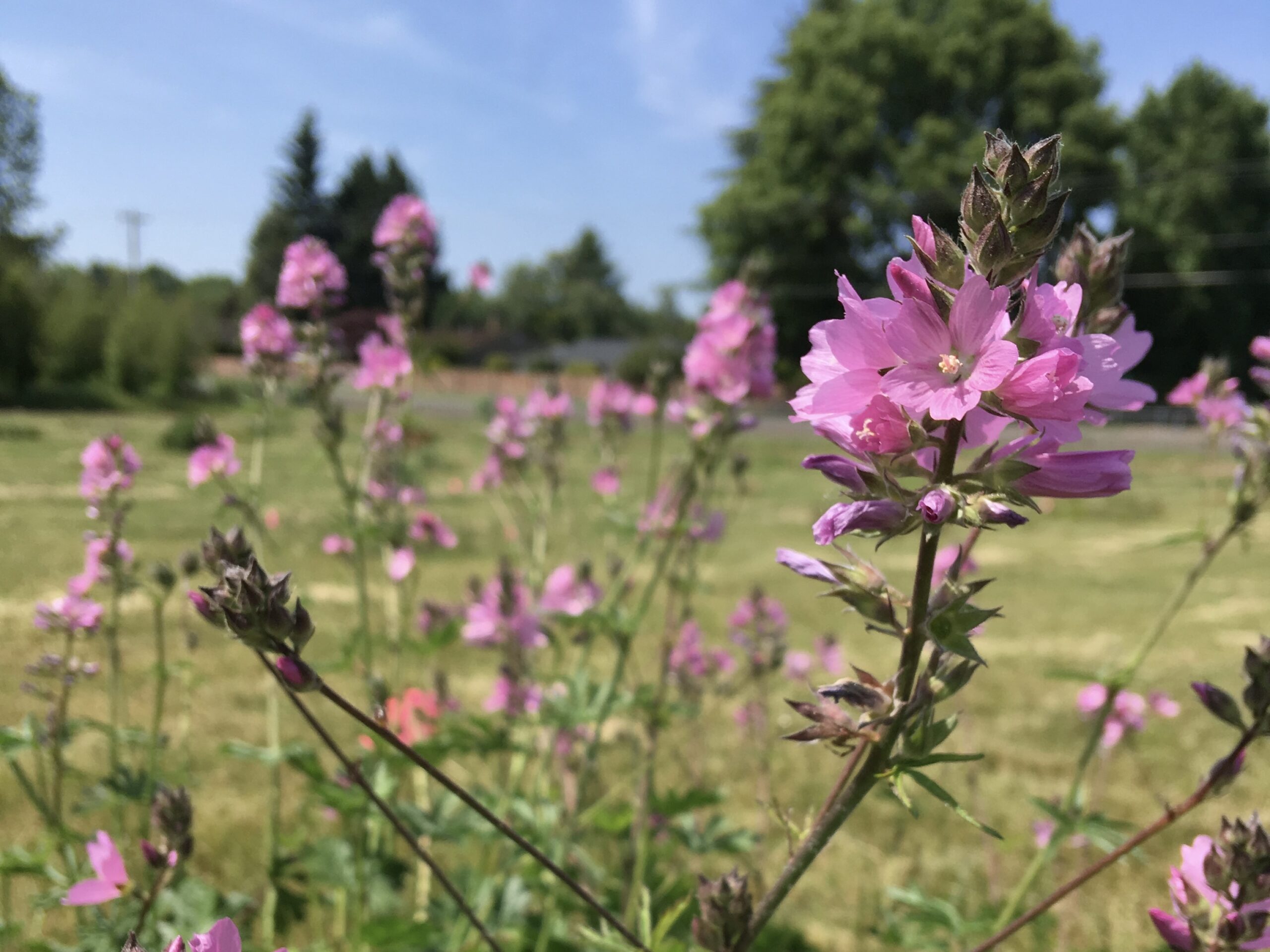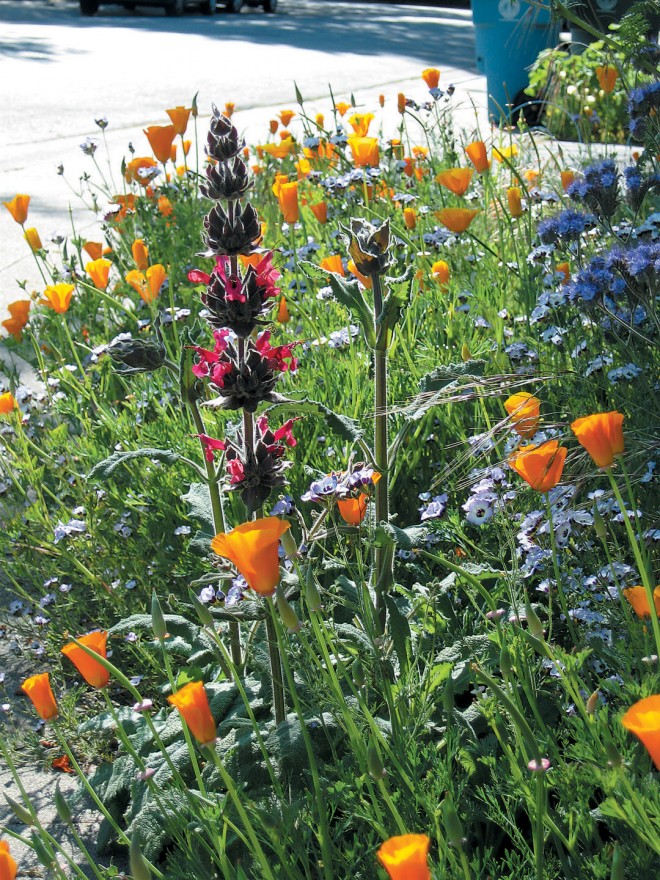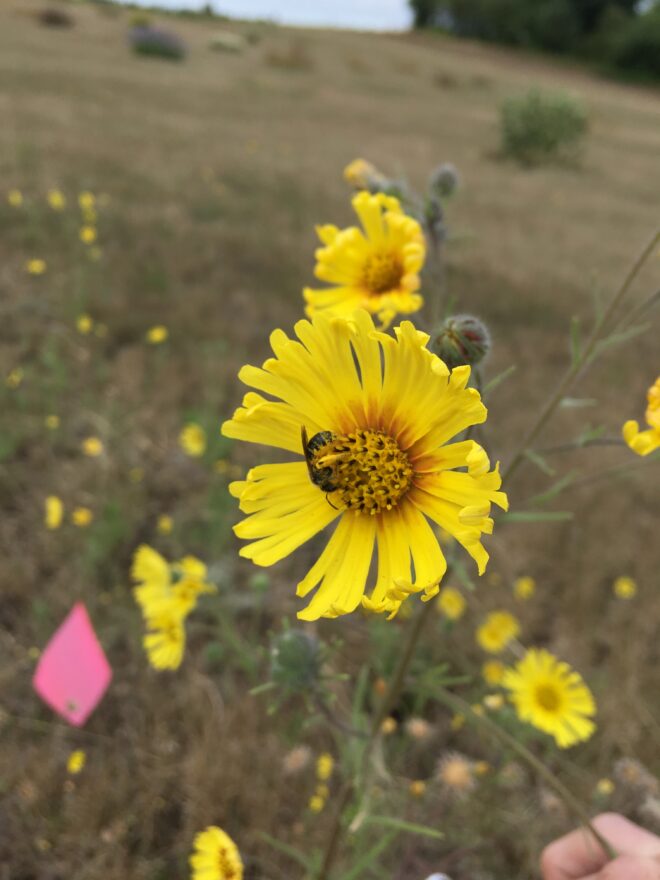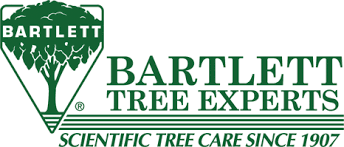
I Did My Graduate Research in a Garden Ecology Lab, This is What Gardeners Want to Know

Contributor
- Topics: Growing for Biodiversity
Spring 2023
The first queen bumble bee I saw this spring hurtled across my front yard a few weeks ago, a bobbing blur of black, yellow, and red banding. She stopped to sip nectar and collect pollen from the few early blooming flowers in the garden, gathering resources to start her new colony. Faced with the stark reality of insect declines, sightings like this hold even more meaning. Studies show decreasing insect populations—including pollinators, across the US and the world.
As individuals, it can be hard to know what to do about conservation issues like this, especially as most of us (statistically) live in urban and suburban areas, removed from big stretches of protected habitat. But it’s not all doom and gloom! Pollinators can make use of small or partial habitats, like gardens and parks, and because of this, studies have found towns and cities can support surprisingly high bee diversity. Not only that, residential landscapes can harbor relatively intact pollinator communities when you compare them with the communities found in surrounding natural areas. By creating pollinator habitat in yards and other urban green spaces, we can increase the amount of habitat available to these species, and even create connectivity to remnant natural habitat.
There is surging interest in gardening for pollinators. Ideally, garden habitat would consist of a diverse suite of native flowering plants that provide resources for not just pollinators, but also the myriad of other beneficial insects that thrive in gardens. But people often only have small spaces available for planting or are overwhelmed by choosing from dozens of plants. In these cases, how do gardeners know the best plants for pollinators? I did my graduate research at Oregon State University (OSU) in the Garden Ecology Lab, and this is the type of information our audience—gardeners throughout Oregon—wanted. In the Pacific Northwest, there had been no comparative study of the attractiveness of plants to pollinators. Because of this, I decided to study top Pacific Northwest bee plants for gardens and other urban greenspaces.
To do this, we were inspired by the only similar research published in the peer-refereed literature, conducted by Doug Landis’s lab at Michigan State University. We screened pollinator plants based on their inclusion on a published pollinator planting list, their drought tolerance, and their ability to grow in full sun. In addition, we wanted to select plants that gardeners would actually use. A member of our lab, Signe Dalner, is a landscape designer, and she drew on her years of experience to help select plants that would work in garden designs. Finally, the plant species needed to be commercially available at retail nurseries.
From an initial list of dozens of candidate species, we whittled it down to 23 Pacific Northwest natives, plus four exotic species known to be attractive in other studies that we used for comparison. In the spring of 2017, we installed these plants in individual one-meter-squared plots across three acres at an OSU research farm, planting perennials as plugs and direct-seeding annual species. With five replicates of each species (plus empty control plots), we had a total of 140 one-meter-squared plots growing. Each was separated from neighboring plots by six meters, and we seeded the space in between with perennial ryegrass to provide a controlled buffer and to suppress weeds.
Sampling
A good bee plant should have two attributes: it should attract a high abundance of bees (the total number of bees that visit it), and it should attract a high species richness (the number of individual species that visit it). If a plant attracts many bees, but only one species visits, that plant is doing nothing to support the broader pollinator community. With just under 4,000 bee species native to North America, there are likely dozens of species that can be found in a yard or park.
We considered both of these factors when conducting our experiment. The week before, during, and after each plot was in peak bloom, we spent five minutes counting all the bees that landed on open flowers. This allowed us to assess the overall abundance of bees visiting these flowers. To investigate the species richness, we vacuumed each plot with an insect vacuum, allowing us to take specimens back to the lab and identify them to species. (Identifying bees to species “on-the-wing” is difficult to do, even for experts).
See more of Aaron Anderson’s Plant Recommendations here.
Findings
After we counted the bees and identified specimens under a dissecting scope, there were a handful of plants that emerged as obvious winners for garden use. These are: California poppy (Eschscholzia california), Canada goldenrod (Solidago canadensis), common madia (Madia elegans), Douglas aster (Symphotrichum subspicatum), farewell-to-spring (Clarkia amoena), globe gilia (Gilia capitata), Oregon sunshine (Eriophyllum lanatum), rose checkermallow (Sidalcea asprella ssp. virgata), varileaf phacelia (Phacelia heterophylla), and yarrow (Achillea millefolium).
All these plants attracted a high overall number of bees and many different types of native bees. Some of these plants had unique associations with native bees, supporting bee species that visited no other plant during the study. All these plants have fairly wide geographic distributions and are able to grow with little supplemental irrigation, making them well suited to use in gardens throughout the West. Of course, it’s important to try to source plants with local genetics whenever possible.
Douglas aster attracted by far the most species-rich bee community, with an estimated 74 bee species visiting it, while also attracting a large number of bees overall. Blooming later in the season, it’s an excellent choice for late-season forage for bees. Bumble bees, fall longhorn bees (Melissodes sp.), and a variety of other native bees visited its deep purple flowers.
California poppy and farewell-to-spring were two other flowers that supported diverse bee communities, visited by an estimated 44 and 45 bee species, respectively. Poppy also supported a high overall abundance of bees, and in particular attracted bumble bees like the yellow-faced bumble bee (Bombus vosnesenskii). (This summer, look for bumble bees “swimming” in circles around the center of poppy flowers.) Farewell-to-spring was unique among our study plants, providing nesting substrate in addition to food for bees. The leafcutter bee Megachile brevis was significantly associated with this flower, snipping circular discs out of its pink petals to line their nests with.
Varileaf phacelia and globe gilia were both highly attractive to bumble bees in particular. As a relatively early-blooming flower, phacelia provides excellent forage for early-season bumble bees, and was significantly associated with three species (Bombus caliginosus, B. mixtus, and B. vosnesenskii). Globe gilia attracted the yellow-faced bumblebee at high numbers, in addition to an estimated 27 other bee species.
Rounding out our top 10 plants were yarrow, rose checkermallow, common madia, Canada goldenrod, and Oregon sunshine. All 10 plants have a variety of colors, growth habits, sizes, and textures, allowing them to work in different kinds of landscape designs. A key consideration when providing habitat for pollinators is to ensure that there is overlapping bloom time throughout the season, and earlier-blooming plants on this list (e.g. varileaf phacelia, California poppy, and farewell-to-spring) can be planted with mid- (such as globe gilia) and late-blooming plants (such as Douglas aster and goldenrod) to provide resources for bees throughout the spring and summer.
Surprisingly, in our study, the non-native garden plants ‘Grosso’ lavender (Lavandula x media ‘Grosso’), oregano (Origanum vulgare), and catnip (Nepeta cataria) were highly attractive to honey bees, but were not particularly attractive to wild bees, with the exception of bumble bee species visiting lavender. Many people can identify honey bees, but not native bees, so it makes sense that plants attractive to honey bees are often cited as being good bee plants. To this point, oregano was found on 93 percent and lavender was found on 87 percent of 15 pollinator plant lists analyzed (Garbuzov and Ratnieks 2014). While these species attract a large overall number of bees, they are likely not the best choice for supporting our thousands of native bee species in the western US.
I do want to note that because a plant didn’t fit our metrics as a good pollinator plant in this study doesn’t mean it isn’t of value. In fact, less popular plants may provide resources for dietary specialist bees that focus on a certain genus or species. Some plants may also be more highly visited in other landscape types containing different communities of bees. Agricultural areas, like where we conducted this study, tend to serve as ecological filters. Lacking a diversity of native plants, they filter out specialist bees, resulting in communities of mostly generalist species. Finally, there are a plethora of plants native to the Pacific Northwest and broader western region that we couldn’t include in this study. Planting a diversity of native plants is the best way to provide robust habitat for invertebrates.
A pleasant surprise was how well the perennial plants performed with no supplemental irrigation, even through two summers where there was hardly any measurable rain between May and September. By the end of the third growing season, plants like Douglas aster, Oregon sunshine, and goldenrod were two to three feet tall, and absolutely covered in flowers. Because of this, the plants we screened in our study can address two goals that ecologically minded home gardeners or landscape designers often have—providing habitat for pollinators and beneficial insects, plus growing well in xeriscaped yards.
Through gardening and landscaping, we can address multiple ecological crises, including insect declines and climate change, by planting intentionally. A yard doesn’t need to be only planted with natives to have value, nor does habitat gardening necessitate a wild or messy landscape. The more we continue to incorporate pollinator plants into our urban and suburban areas, the better these landscapes will be able to serve as functional habitat for pollinators and other invertebrates. Hopefully, the plants we identified via this study can serve as a starting point for people just diving into pollinator plantings, or guide decision-making for gardeners looking to choose new bee plants for existing pollinator habitat.
Resources
For further information, follow the Oregon State University Garden Ecology Lab. OSU Extension has also compiled a list of “Native Plant Picks for Bees.”
Anderson, Aaron G., Lucas Costner, Lincoln Best, and Gail Langellotto. 2022. “The bee fauna associated with Pacific Northwest (USA) native plants for gardens.” Conservation Science and Practice. 4(10).
Anderson, Aaron G., Isabella Messer, and Gail A. Langellotto. 2021. “Gardeners’ Perceptions of Northwestern U.S. Native Plants Are Influenced by Ecological Information and Garden Group Affiliation.” HortTechnology. 31(4): 458–469.
Garbuzov, Mihail and Francis L. W. Ratnieks. 2014. “Listmania: The Strengths and Weaknesses of Lists of Garden Plants to Help Pollinators.” Bioscience 64 (11): 1019–1026.
This article was made possible by the generous Sponsorship support of Bartlett Tree Experts


















Responses